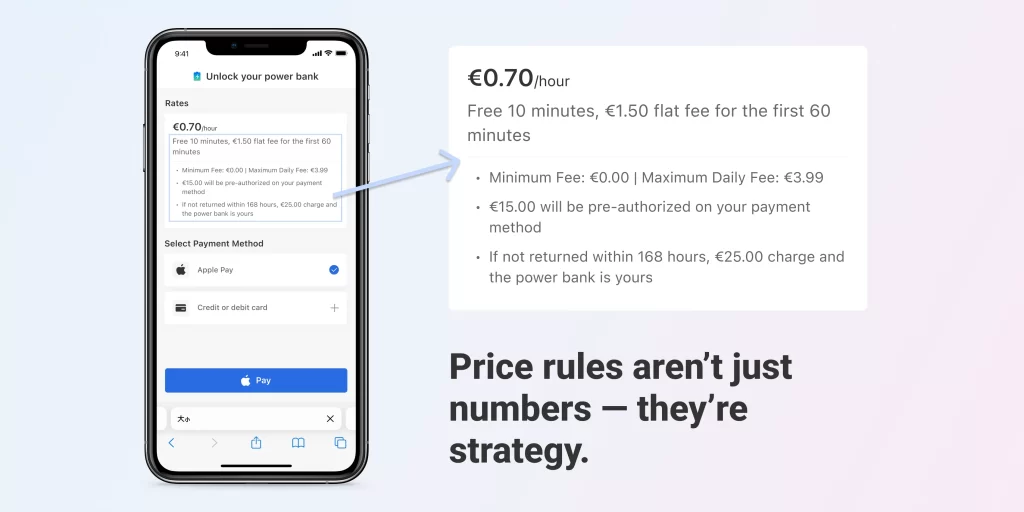
In the shared power bank industry, hourly billing is the undisputed pricing backbone. Yet, as price wars become unsustainable, the true competitive edge often hides in a meticulously crafted set of supporting rules. These details don’t overthrow the core pricing model; instead, they represent a refined operational art that boosts conversion, repeat usage, and asset turnover while preserving a sense of fairness.
Table of Contents
- Part 1. Flat Rates Are Dead; Scenario-Based Billing Is the Future
- Part 2. Rule Design: Precision Targeting for Different Scenarios
- 2.1 Free Minutes + Flat First-Hour Price: Overcome Hesitation, Spark Instant Demand
- 2.2 Daily Cap: Build “Peace of Mind,” Encourage Longer Rentals
- 2.3 Extended Max Rental + Modest Premium: Serve Travelers, Capture High-Value Needs
- 2.4 Cumulative Max + Overdue Buyout: Turn Disputes into Deals, Set Ultimate Boundaries
- 2.5 Return Guidance & Pre-Authorization: Enhance UX and Manage Risk
- Part 3. Underlying Logic: Behavioral Economics in Billing Rules
- Conclusion
Part 1. Flat Rates Are Dead; Scenario-Based Billing Is the Future
User needs vary wildly: a hurried businessperson might need just 10 minutes of emergency juice, a leisurely shopper could require all-day support, and a cross-city traveler faces multi-day battery challenges. A single hourly rate can’t precisely match these diverse scenarios and expectations.
That’s why a layered rule set is essential to create a seamless experience loop:
- Acquisition Layer: Free initial minutes, flat first-hour price
- Protection Layer: Daily cap, cumulative maximum
- Boundary Layer: Maximum rental period, overdue buyout clause
- Risk Layer: Pre-authorization hold, nearby return guidance
Together, these lower decision barriers, ease usage anxiety, clarify responsibilities, and streamline returns.

All prices mentioned in this article and accompanying visuals are fictional examples and do not constitute pricing recommendations.
Part 2. Rule Design: Precision Targeting for Different Scenarios
2.1 Free Minutes + Flat First-Hour Price: Overcome Hesitation, Spark Instant Demand
Scenario: High-traffic, short-stay spots like fast-food outlets, subway entrances, or convenience stores.
Strategy: Offer 5–10 minutes free, with a flat first-hour price of €1.20–€1.50. The free window is the “final nudge” to dispel doubt, while the flat rate eliminates mental math, driving quick uptake through crystal-clear simplicity.
2.2 Daily Cap: Build “Peace of Mind,” Encourage Longer Rentals
Scenario: Malls, cinemas, or office districts with extended dwell times.
Strategy: Set a daily cap at €3.49–€3.99, clearly stating “resets every 24 hours.” This caps the “worst-case” cost, reassuring users and freeing them to rent longer without fear of runaway bills.
2.3 Extended Max Rental + Modest Premium: Serve Travelers, Capture High-Value Needs
Scenario: Airports, high-speed rail stations, or long-distance bus terminals.
Strategy: Allow 120–168 hours max rental, paired with a slight first-hour premium (€1.80–€2.00) and higher daily cap (€4.49–€4.99). For travelers, certainty and convenience trump tiny price differences—this hits their core pain points perfectly.
2.4 Cumulative Max + Overdue Buyout: Turn Disputes into Deals, Set Ultimate Boundaries
Core Strategy: Align cumulative max and overdue buyout at €25.
- The cumulative cap shields long-term legitimate users (“no matter how long, there’s a ceiling”).
- The buyout price turns “non-return” incidents into a clean, bounded transaction (“pay €25, keep the device”).
Value: This transforms costly recovery headaches and lost devices into predictable revenue, while erasing fears of “sky-high bills.”
2.5 Return Guidance & Pre-Authorization: Enhance UX and Manage Risk
Return Guidance: Dynamically show nearby drop-off points and walking times during rental—soft insurance against overdue friction.
Pre-Authorization (€15): Primarily for risk control. Keep it transparent.
Part 3. Underlying Logic: Behavioral Economics in Billing Rules
These rules work because they nail deep psychological triggers:
- Anchoring Effect: Flat first-hour and daily cap prices create intuitive value benchmarks.
- Loss Aversion: Clear ceilings ease anxiety over unknown costs far better than minor discounts.
- Decision Simplicity: Default options (like flat packages) slash cognitive load and friction.
- Peak-End Rule: On successful return, flash “You saved €X thanks to the cap”—a positive endpoint that cements satisfaction and repeat intent.
Conclusion
While the industry drowns in “drop another €0.10 per hour” quicksand, the real breakout lies in billing ingenuity woven into the user decision chain. These are precision gears driving dual flywheels of experience and efficiency. Price competition does have an end; the journey of detail design never does.
Theory ends where action begins. With proven global case studies and a comprehensive dynamic pricing database, we’re ready to power your decision-making. Whether deepening local markets or scaling worldwide, let’s set the next operational standard together.



